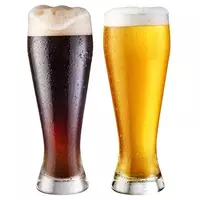Beer lager

Lager beer was made for the first time over 500 years ago. Since that very moment, beer lager is included in the list of the most popular and common varieties of foam drink. Lager beer got its original name thanks to the German word Lagerbier, which, when literally translated, means "beer that ripens when stored. " It is no coincidence that lager received this name for beer. The thing is that just in the 16th century, German brewers brewed beer in winter so that the drink was ready for sale by summer.
A special technique for the production of lager beer allowed for a long time to maintain the taste and consumer characteristics of the drink. As a rule, in the Middle Ages, lager beer was preserved in barrels, which were placed in special basements under a thick layer of ice. Beer lager refers to beverages that are produced by a low fermentation technique. In the process of producing beer, lager uses yeast of the species Saccharomyces uvarum, and in addition Saccharomyces carlsbergensis.
After the fermentation process is completed, yeast cultures settle on the bottom of a special fermentation vat, thereby forming a precipitate. This distinguishes the process of grassroots fermentation from the upper one. However, it is worth noting that during grassroots fermentation, the process of making a drink takes a much longer time, since according to the technological process, fermentation should gradually proceed at a temperature of 6 to 9S. Beer, including low-fermentation lager, can be stored for a long time without losing its exceptional taste and consumer characteristics.
It is worth noting that currently 80% of all beer is represented by the type of lager. It is believed that thanks to the production technology, beer lager has improved properties in comparison with drinks made according to a different method. The process of producing lager beer involves more than just a bottom fermentation process. After fermentation, the beverage goes through a fermentation process at low temperatures. In the final stage of production, lager beer is bottled.
In the vast majority of cases, bottle beer is pasteurized by a fine filtration process. there are two main varieties of lager beer. Light and dark, often almost black in color beer lager. In addition to the above varieties, the following most common subspecies of lager beer can be distinguished:
American light beer lager;
Munich light beer lager;
hel;
Dortmund light beer lager;
the German, American and Bohemian Pilsner;
amber lager from Vienna;
March beer lager;
dark American lager;
black beer Schwarzbir;
side.
beer lager 33 kCal
Energy value of beer lager (Ratio of proteins, fats, carbohydrates - ju):
Proteins: 0.3 g (~ 1 kCal)
Fats: 0 g (~ 0 kCal)
Carbohydrates: 4.6 g (~ 18 kCal)
Energy ratio (bj | y): 4% | 0% | 56%
 Español
Español Français
Français Português
Português Русский
Русский 简体中文
简体中文 繁體中文
繁體中文 日本語
日本語 한국어
한국어 العربية
العربية Türkçe
Türkçe Қазақ
Қазақ Deutsch
Deutsch Italiano
Italiano Українська
Українська
